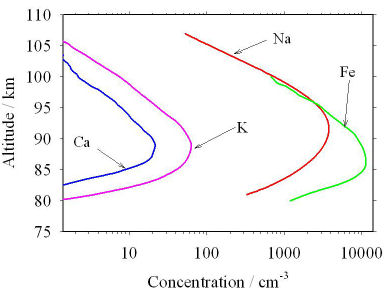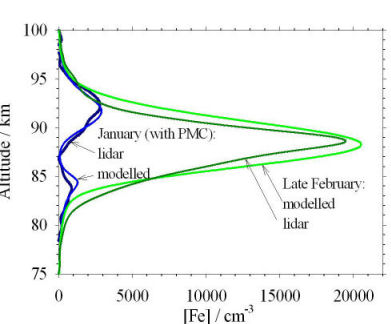Metal Layers
Middle/Upper Atmosphere Modelling, Current Research.
About 50 tonnes of interplanetary dust enters the earth's atmosphere every day, at velocities ranging from 11 to 72 km s-1. Most of this dust appears to vaporize completely, producing the layers of metal atoms such as Na and Fe that occur globally in the upper mesosphere and lower thermosphere (between 80 and 105 km). Several metal atoms - Na, K, Fe and Ca - can be observed by ground-based lidar (laser radar), and this has provided a great deal of information about the physics and chemistry of an important region that forms the boundary between the atmosphere and space.
Our main contribution to this field has been to study the elementary reactions that these metals undergo in the upper atmosphere. The resulting reaction rate coefficients and photochemical cross sections are then used to construct models. The laboratory techniques that we use are: laser flash photolysis with detection of metallic species by laser induced fluorescence; and the fast flow tube with detection of neutral species by LIF, and ions by mass spectrometry. For a review of these techniques, see Plane, Chemical Reviews, 2003. Below are tables of recommended rate coefficients from our laboratory studies.
 Layers of metal atoms in the mesosphere/lower thermosphere, observed by lidar at mid-latitude northern hemisphere observatories.
Layers of metal atoms in the mesosphere/lower thermosphere, observed by lidar at mid-latitude northern hemisphere observatories.
 Modelling the Fe layer at South Pole during summer. Uptake coefficients of Fe and Fe species on ice = 1. Plane et al., Science, 2004.
Modelling the Fe layer at South Pole during summer. Uptake coefficients of Fe and Fe species on ice = 1. Plane et al., Science, 2004.




Comparison of lidar observations of the Na and Fe layers at South Pole with the results of the Leeds metal layer model (Gardner et al., 2005).
